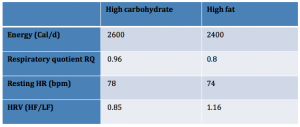 On Saturday I attended and presented at, a Sports Nutrition event in London aimed at sports professionals and athletes aiming to get the very most out of their bodies. It was run by nutritionist Matt Lovell, with a substantial contribution by ultra-runner Barry Murray. Both advise athletes and teams at the very top level, and I have to say it is not often that I learn so much I didn’t know before in one day!
On Saturday I attended and presented at, a Sports Nutrition event in London aimed at sports professionals and athletes aiming to get the very most out of their bodies. It was run by nutritionist Matt Lovell, with a substantial contribution by ultra-runner Barry Murray. Both advise athletes and teams at the very top level, and I have to say it is not often that I learn so much I didn’t know before in one day!
Nutrition & Endurance Sports
As endurance athletes, I think we tend to take a luddite approach to nutrition in general and especially to supplementation compared to team and power sports. Carbs are sacred and supplements unnecessary, right? Well, wrong, and very wrong, as Matt and Barry spent much of the day explaining.
Endurance training is hard on the body, because it is long and frequent, if not always intense. In fact, endurance training is often catabolic and results in loss of muscle mass unless lifestyle factors are carefully managed, and it’s not just a case of eating more lean protein to offset this.
Key aspects we need to get right are:
- Availability of electrolytes – Magnesium deficiency is common and can lead to cramping as it is required to switch muscles off
- Testosterone vs cortisol balance. Both are needed, but at the right times, and loss of libido (as well as reduced heart rate variability (HRV)) are clues as to when this is wrong
- Inflammation is the enemy of recovery, and of health in general (most of us will end up dying from conditions started by inflammation). Researcher Julian Thayer has done pioneering work looking at associations between inflammation and HRV, noting that reduced parasympathetic activity may even be involved in switching on the inflammatory process.
- Preserving both muscle mass through weight training and the number of mitochondria in the muscle for respiration and energy production.
Heart health is a topic close to the umm heart of many endurance athletes, and as we age, palpitations and rhythmic disturbances become common. Matt’s view is that many of these can be avoided by taking sufficient magnesium, taurine, vitamin K and omega 3 fatty acids. The omega 6:3 ratio is typically much too high without taking either omega 3 supplements (EPA, DHA) or plenty of oily fish.
Another key organ is the liver which can’t do its job well if it is spending lots of effort processing toxins including alcohol!
Fat Burning
Barry Murray is an expert on fat adaptation and has many anecdotes as well as solid scientific evidence for how butter and eggs can not only fuel your extensive activity but also make you healthier overall. One thing I didn’t know before is that the body burns saturated fats cleanly and efficiently with much less oxidative stress from free radicals than using carbohydrates. The body’s insulin reactivity becomes better, reducing the chances of type 2 diabetes and energy spikes through the day.
Becoming a fat-burning machine does take many months and has to be done gradually – you can’t switch your diet overnight but when well-managed, the fat-burning machine can eventually produce up to 1000 kCal/hr – enough for top-level Ironman and marathon competition. Barry had lots of suggestions for how to manage this transition including intermittent fasting and training on empty, which apparently isn’t as painful as it sounds because the nature of your hunger changes as the adaptation progresses. The low glucose state also triggers mitochondrial production via AMPK signalling.
Nutrition & Heart Rate Variability (HRV)
During my section on HRV, I covered the stages of training progression through overreaching to the relatively rare states of overtraining (both sympathetic and parasympathetic) as well as the hormone changes involved. I also talked about the impact on HRV of dietary choices and common supplements such as caffeine and omega 3 supplements.
The findings on caffeine are surprisingly ambiguous. Whereas we usually think of caffeine as being a stimulant, and therefore something that might activate the fight or flight response, a study by Hibino in 1997 found that caffeine actually increases HRV about 30 minutes after it is taken. We also covered a study by Mike Nelson that showed very little impact on HRV of energy drinks, at least when consumed in moderate quantities. At higher quantities, it does seem like a sympathetic response is produced, but the mechanism by which it acts is still open to debate.
Fish oils (omega 3 fatty acids) do increase HRV, but as we explained in this post, the mechanism may involve slowing the pacemaker region of the heart down directly, rather than through nervous system input. Nonetheless, fish oils are cardioprotective and all the experts seem to agree they should figure strongly in a heart-healthy diet.
When it comes to energy sources, a study in 2009 by Millis looked at how the body reacted to (liquid) diets that strongly favoured either carbohydrates or fats. What they found was higher parasympathetic HRV (HF: LF ratio) and lower resting heart rate in the high-fat diet. What was also interesting was that the control group that fasted rather than having any food in the morning had an even higher HRV. Other studies on fasting had similar findings, with HRV increasing for the first 24 hours, then decreasing to 48 hours, perhaps signifying energy system stress building up after the initial fasting period.
When it comes to complete diets, the Mediterranean diet is often associated with Longevity and low rates of heart disease. A recent study looked at a cross-section of the population and asked them to evaluate their diet using a questionnaire for the Mediterranean diet ingredients such as cereals, vegetables, fruits and nuts, legumes, fish, and a high ratio of monounsaturated to saturated fatty acids. They measured HRV across this population and found a difference of about 20% (4 ithlete units) between the highest and lowest levels of the group.

